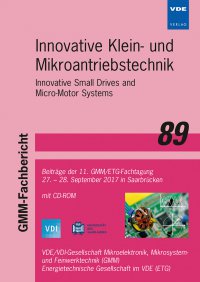Trends in the Sector of Small- and Servodrives
Konferenz: Innovative Klein- und Mikroantriebstechnik - 11. GMM/ETG-Fachtagung
27.09.2017 - 28.09.2017 in Saarbrücken, Deutschland
Tagungsband: Innovative Klein- und Mikroantriebstechnik
Seiten: 8Sprache: EnglischTyp: PDF
Persönliche VDE-Mitglieder erhalten auf diesen Artikel 10% Rabatt
Autoren:
Dempewolf, Kay-Horst; Konstas, Georg; Groening, Ingolf (WITTENSTEIN cyber motor GmbH, Igersheim, Germany)
Inhalt:
The present article aims to give an overview on different application areas of the servo drive technology within automotive traction drives, the oil industry and gas industry, the medicine technology, the aviation technology, the robotics and the general industry. On this occasion, specific requirements of the above-mentioned areas will be pointed out and separated mutually. In this manner, it is clear which of these requirements have a determining influence on the development targets. Evidently, some individual development targets are identical, however technical or ambient requirements lead to different developing results in the above mentioned application areas. In this regard, this article is about development focuses of the permanent magnet synchronous machine as for example the mechanical requirements of stator or rotor by oscillations or vibrations. Furthermore, requirements concerning high ambient pressure, the highest temperatures above 200 °C or also vacuum will be pointed out. Even radioactive radiation is a requirement for the robustness of electricalmotorsAn additional subject is the mechanical tension on the rotor caused by centrifugal forces due to the high speeds of the servo drive up to 270,000 rpm. When it comes to applications in medicine technology in or on the human body, it is not rare that the requirements lead to an electrical machine who has losses which are reduced to a minimum. In this connection, deep and decisive knowledge concerning the choice of materials is necessary. In the area of aviation technology weight savings and robustness within the specified environmental conditions count predominantly. On the one hand highly efficient and integrated servo drive solutions within a minimum construction space can score here. On the other hand lightweight construction with the help of plastics and special materials offer a clear advantage over market competitors. In addition to the technical requirements and ambient conditions the scenarios of different quantities with regard to the industrialisation are of high importance. If merely two-digit annual quantities of a servo drive are planned, a manufacture within the production is also a tried and tested way for a cost-effective, high-quality assembly and fabrication of products. Corresponding to the electromagnetic design it can be cheaper, for example if stator and rotor lamination stacks are laser cut according to requirement. As soon as annual numbers of pieces increase strongly, the level of automation within manufacturing has to be raised considerably to reduce production costs and to reach high-quality standards through process supervision. The investment in tools, as for example successive cut punching tools or gravity die-casting tools, is a decisive step to lower production and process costs. With the help of these an advantage can be achieved to successfully persist on the market. Precisely because of the constant cost pressure within the mentioned areas, development loops with secondary products or product variations do continuously increase efficiency and automation within the assembly and production processes. Specific trends within the servo drive technology that will be mentioned in this article can be derived from the requirements of the different application areas respectively. Generally, an individualisation within the aforementioned application areas can be ascertained. Often this results in a high number in product variations with manufacturers wherein it is cost-effective if these variations are made on the same production lines. Accordingly challenges follow for the investment or automation sector. Important requirements are for that matter high temperature resistance, high dynamic requirement on the servo drive or speed-up to increase the power density. The increase in efficiency or the improvement of magnet materials is another trend within the electric drive technology in case of the permanent magnet synchronous machines. The inquiry for servo drive systems instead of single components is also evident. Switching losses, switching frequency or also system analysis play a higher role. At the end, the article offers a summary of the named subjects and provides an outlook for trends in close future.


